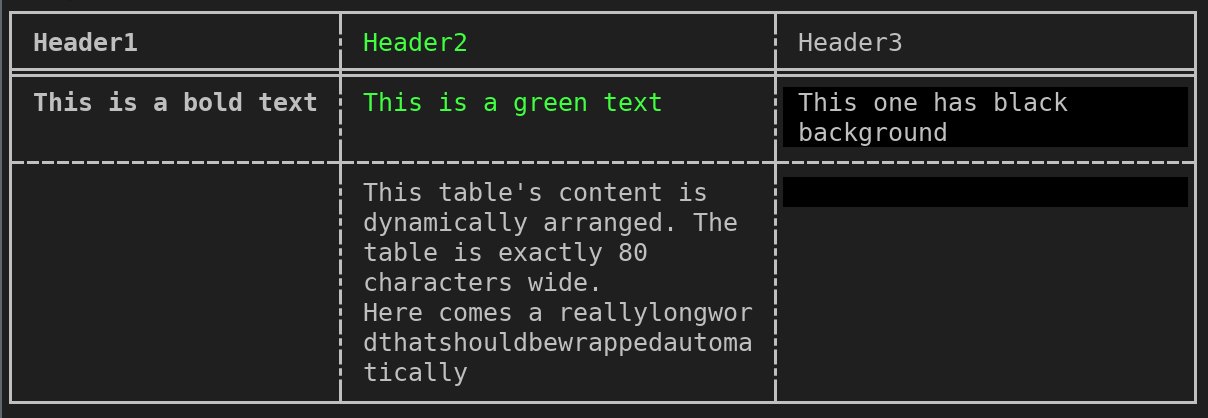Comfy-table

Comfy-table tries to provide utility for building beautiful tables, while being easy to use.
Warning: This library is quite young and very actively developed. There still may be some bugs, event though I'm continuously writing tests to cover all features. If you find anything, please create an issue. I'll then try to fix them as soon as possible.
Features:
- Dynamic arrangement content to a specific width.
- Content styling for terminals (Colors, Bold, Blinking, etc.).
- Presets and preset modifiers to get you started.
- Pretty much every part of the table is customizable (borders, lines, padding, alignment).
- Constraints on columns that allow some additional control over how to arrange content.
- Cross plattform (Linux, macOS, Windows).
- I probably forgot some stuff...
A Basic Table
use *;
Create a very basic table.
This table will become as wide as your content, nothing fancy happening here.
+----------------------+----------------------+------------------------+
| Header1 | Header2 | Header3 |
+======================================================================+
| This is a text | This is another text | This is the third text |
|----------------------+----------------------+------------------------|
| This is another text | Now | This is awesome |
| | add some | |
| | multi line stuff | |
+----------------------+----------------------+------------------------+
More Features
use *;
use UTF8_FULL;
use UTF8_ROUND_CORNERS;
Create a table with UTF8 styling, and apply a modifier, which gives the table round corners.
Additionall the content will dynamically wrap to maintain a given table width.
If the table width isn't explicitely set, the terminal size will be used, if this is executed in a terminal.
On top of this, we set the default alignment for the right column to Right and the Alignment of the left top cell to Center.
╭────────────┬────────────┬────────────╮
│ Header1 ┆ Header2 ┆ Header3 │
╞════════════╪════════════╪════════════╡
│ This is a ┆ This is ┆ This is │
│ text ┆ another ┆ the third │
│ ┆ text ┆ text │
├╌╌╌╌╌╌╌╌╌╌╌╌┼╌╌╌╌╌╌╌╌╌╌╌╌┼╌╌╌╌╌╌╌╌╌╌╌╌┤
│ This is ┆ Now ┆ This is │
│ another ┆ add some ┆ awesome │
│ text ┆ multi line ┆ │
│ ┆ stuff ┆ │
╰────────────┴────────────┴────────────╯
Styling
use *;
use ;
use UTF8_FULL;
This code generates the table that can be seen at the top of this Readme.
More Examples
If you're looking for examples, take a look at the tests folder.
There is a test for almost every feature including a visual view for each resulting table.
Feedback
This is my first Rust library! If you have some suggestions on how to improve this library please create an issue. I'm always open to constructive criticism and eager to learn how to do this properly!



